An outside day remains within a small range. Both short-term Elliott wave counts remain valid.
Summary: At this stage, it is possible that minor wave 3 could be over. Confidence in this view is required with a new low below 3,212.03.
If price continues higher, then the next target would be at 3,289.
Three large pullbacks or consolidations (fourth waves) during the next 1-2 years are expected: for minor wave 4 (coming soon, possibly tomorrow), then intermediate (4), and then primary 4. Extreme conditions warrant more careful attention to risk management at this time.
The biggest picture, Grand Super Cycle analysis, is here.
Monthly charts were last published here, with video here. There are two further alternate monthly charts here, with video here.
ELLIOTT WAVE COUNTS
The two weekly Elliott wave counts below will be labelled First and Second. They may be about of even probability. When the fifth wave currently unfolding on weekly charts may be complete, then these two wave counts will diverge on the severity of the expected following bear market. To see an illustration of this future divergence monthly charts should be viewed.
FIRST WAVE COUNT
WEEKLY CHART
The basic Elliott wave structure consists of a five wave structure up followed by a three wave structure down (for a bull market). This wave count sees the bull market beginning in March 2009 as an incomplete five wave impulse and now within the last fifth wave, which is labelled cycle wave V. This impulse is best viewed on monthly charts. The weekly chart focusses on the end of it.
Elliott wave is fractal. This fifth wave labelled cycle wave V may end a larger fifth wave labelled Super Cycle wave (V), which may end a larger first wave labelled Grand Super Cycle wave I.
The teal Elliott channel is drawn using Elliott’s first technique about the impulse of Super Cycle wave (V). Draw the first trend line from the end of cycle wave I (off to the left of the chart, the weekly candlestick beginning 30th November 2014) to the end of cycle wave III, then place a parallel copy on the end of cycle wave II (off to the left of the chart, the weekly candlestick beginning 14th February 2016). This channel perfectly shows where cycle wave IV ended at support. The strongest portion of cycle wave III, the end of primary wave 3, overshoots the upper edge of the channel. This is a typical look for a third wave and suggests the channel is drawn correctly and the way the impulse is counted is correct.
Within Super Cycle wave (V), cycle wave III is shorter than cycle wave I. A core Elliott wave rule states that a third wave may never be the shortest. For this rule to be met in this instance, cycle wave V may not be longer in length than cycle wave III. This limit is at 3,477.39.
Cycle wave V may subdivide either as an impulse or an ending diagonal. Impulses are much more common, and it is clear at this stage that cycle wave V is an impulse and not a diagonal.
At this stage, cycle wave V may take another one to two or so years to complete.
The daily chart below will focus on movement from the end of intermediate wave (2) within primary wave 3.
In historic analysis, two further monthly charts have been published that do not have a limit to upwards movement and are more bullish than this wave count. Members are encouraged to consider those possibilities (links below summary) alongside the wave counts presented on a daily and weekly basis. It is my judgement that the two weekly wave counts published in this analysis have the highest probability, so they shall be the only wave counts published on a daily basis.
Within cycle wave V, primary waves 1 and 2 may be complete. Within primary wave 3, intermediate waves (1) and (2) may be complete. Within the middle of intermediate wave (3), minor wave 4 may not move into minor wave 1 price territory below 3,021.99.
DAILY CHART
All of primary wave 3, intermediate wave (3) and minor wave 3 may only subdivide as impulses.
Minor wave 3 has passed 1.618 the length of minor wave 1, and within it minute wave v has passed equality in length with minute wave i. The next target may be now about 3,289 where minuette wave (v) within minute wave v would reach 1.618 the length of minuette wave (i).
Minor wave 2 was a sharp deep pullback, so minor wave 4 may be expected to be a very shallow sideways consolidation to exhibit alternation. Minor wave 2 lasted 2 weeks. Minor wave 4 may be about the same duration, or it may be a longer lasting consolidation. Minor wave 4 may end within the price territory of the fourth wave of one lesser degree; minute wave iv has its range from 3,154.26 to 3,070.49.
Minor wave 4 may not move into minor wave 1 price territory below 3,021.99.
Intermediate wave (3) has now moved far enough above the end of intermediate wave (1) to allow intermediate wave (4) to unfold and remain above intermediate wave (1) price territory.
Draw an acceleration channel now about intermediate wave (3): draw the first trend line from the end of minor wave 1 to the last high, then place a parallel copy on the end of minor wave 2. Keep redrawing the channel as price makes new highs. Minor wave 4 may find support at the lower edge of this channel if it is long lasting or deep enough.
Price is approaching the upper edge of the wide teal channel copied over from monthly and weekly charts. If price gets up to this trend line, then a reaction downwards there would be highly likely.
HOURLY CHART
It is possible that minor wave 3 may be close to completion.
This best fit channel is removed. It was no longer showing where price was finding support.
Within minuette wave (v), subminuette wave ii may not move beyond the start of subminuette wave i below 3,212.03.
ALTERNATE HOURLY CHART
If price breaks below 3,212.03, then assume minor wave 4 has arrived.
If minor wave 4 ends within the price territory of the fourth wave of one lesser degree, then it may end about the 0.382 Fibonacci ratio of minor wave 3 about 3,105.
To begin a movement at minor degree a five wave structure downwards should develop on the hourly chart. Within the first five down, minuette wave (ii) may not move beyond the start of minuette wave (i) above 3,258.14.
SECOND WAVE COUNT
WEEKLY CHART
This weekly chart is almost identical to the first weekly chart, with the sole exception being the degree of labelling.
This weekly chart moves the degree of labelling for the impulse beginning in March 2009 all down one degree. This difference is best viewed on monthly charts.
The impulse is still viewed as nearing an end; a fifth wave is still seen as needing to complete higher. This wave count labels it primary wave 5. Primary wave 5 may still need another year to two or so to complete, depending upon how time consuming the corrections within it may be.
Primary wave 5 may be subdividing as an impulse, in the same way that cycle wave V is seen for the first weekly chart.
TECHNICAL ANALYSIS
MONTHLY CHART
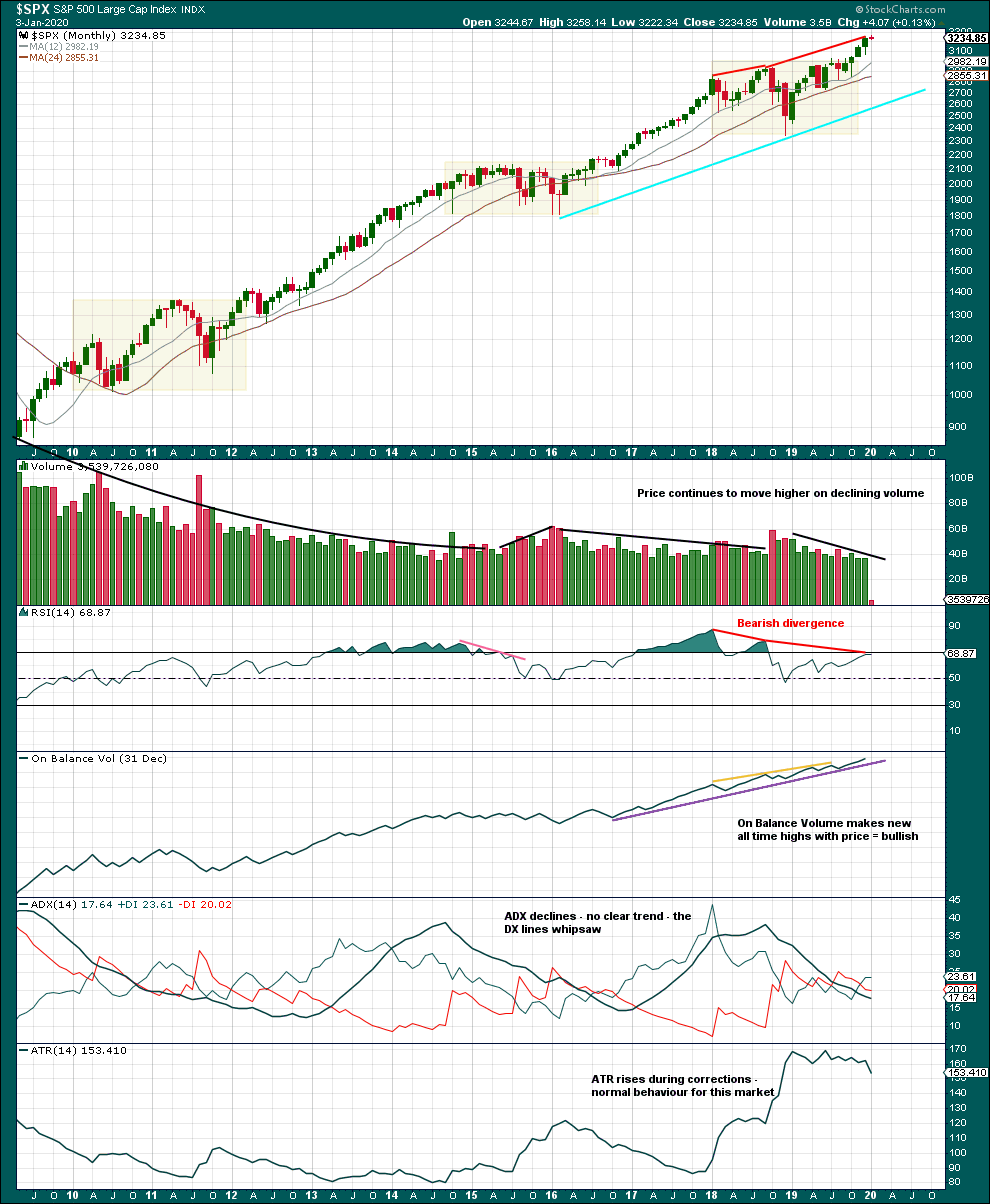
Click chart to enlarge. Chart courtesy of StockCharts.com.
There are three large consolidations noted on this chart, in shaded areas. After a breakout from a multi-month consolidation, it is reasonable to expect a multi month bullish move may result.
Note that in each of the first two cases a pullback saw price re-enter the consolidation zone after the breakout, before price then moved up and away. It is possible that may happen again after the last breakout from a consolidation.
This chart very clearly exhibits rising price on declining volume has now persisted for several years. A decline in volume last month, in current market conditions, is not of concern.
On Balance Volume supports the Elliott wave count.
WEEKLY CHART
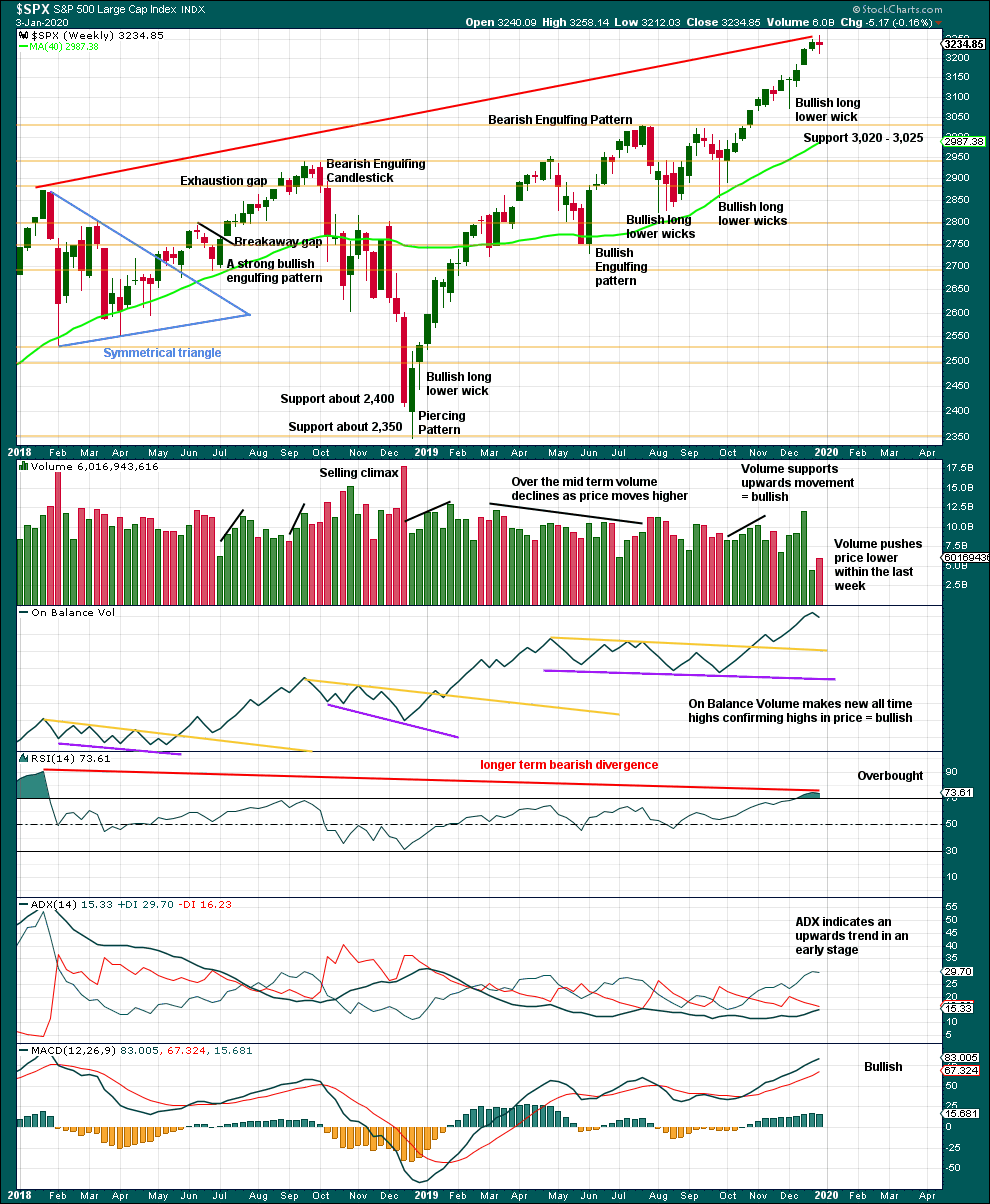
Click chart to enlarge. Chart courtesy of StockCharts.com.
It is very clear that the S&P is in an upwards trend and the bull market is continuing. Price does not move in straight lines; there will be pullbacks and consolidations along the way.
This chart is overall bullish. There are no signs of weakness in upwards movement.
RSI is now overbought. That does not mean upwards movement must end here, because it can continue for several weeks while RSI reaches more extreme. RSI reaching overbought is a warning that conditions are now becoming extreme. A pullback or consolidation will follow and the longer conditions are extreme the closer this will be. However, assume the trend remains the same until proven otherwise. This warning should be heeded by careful attention to risk management.
The doji last week on its own is not a reversal signal. It is a sign of a small pause.
DAILY CHART
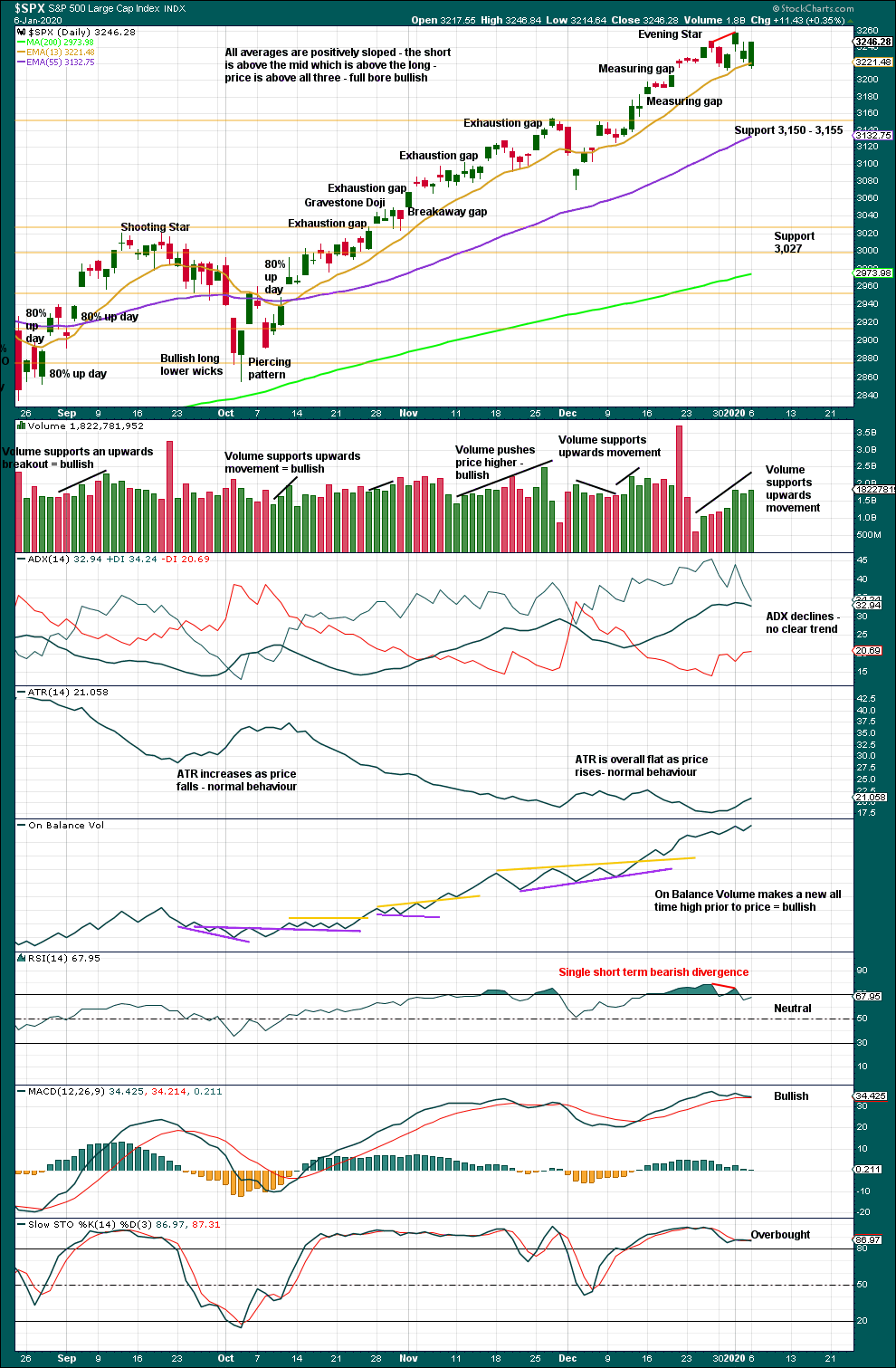
Click chart to enlarge. Chart courtesy of StockCharts.com.
There is an upwards trend in place. There will be corrections along the way.
Like the weekly chart, this chart is bullish.
RSI now exhibits bearish divergence while overbought. This is often (not always) a warning of a pullback or consolidation to develop.
Today a new all time high from On Balance Volume supports the main hourly Elliott wave count.
BREADTH – AD LINE
WEEKLY CHART
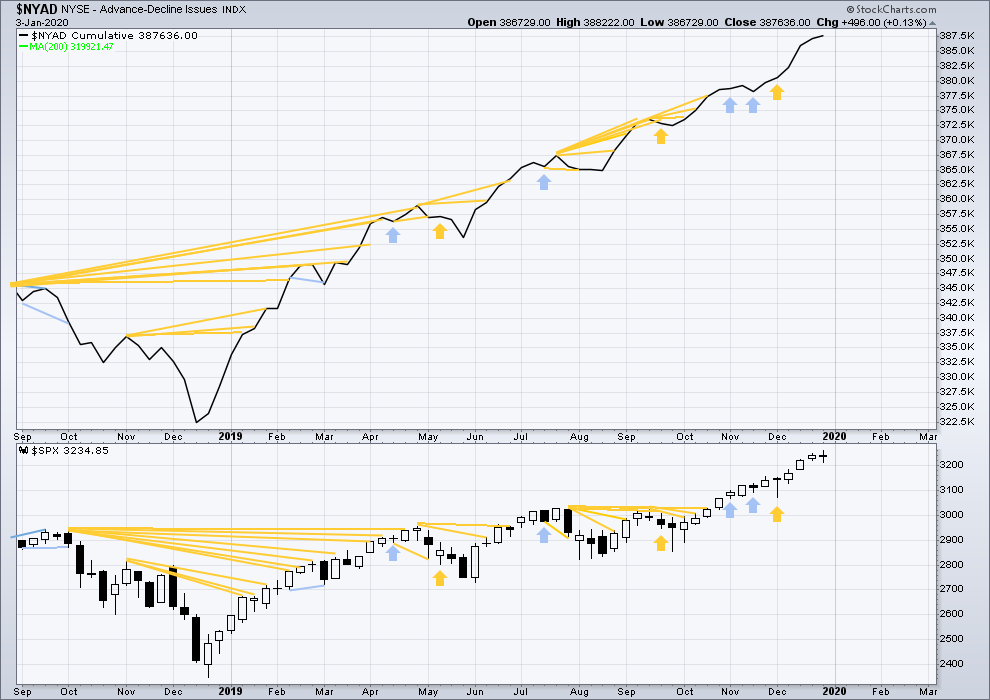
Click chart to enlarge. Chart courtesy of StockCharts.com. So that colour blind members are included, bearish signals
will be noted with blue and bullish signals with yellow.
Bear markets from the Great Depression and onwards have been preceded by an average minimum of 4 months divergence between price and the AD line with only two exceptions in 1946 and 1976. With the AD line making new all time highs this week, the end of this bull market and the start of a new bear market is very likely a minimum of 4 months away, which is the beginning of May 2020.
In all bear markets in the last 90 years there is some positive correlation (0.6022) between the length of bearish divergence and the depth of the following bear market. No to little divergence is correlated with more shallow bear markets. Longer divergence is correlated with deeper bear markets.
If a bear market does develop here, it comes after no bearish divergence. It would therefore more likely be shallow.
All of small, mid and large caps have made new swing highs above the prior swing high on the 13th of September, and mid caps have now made new all time highs. This upwards movement appears to be mostly driven by large caps, which is a feature of aged bull markets. This bull market at over 10 years duration certainly fits the definition of aged.
Again both price and the AD line have made new all time highs. There is no divergence. Upwards movement has support from rising market breadth.
Large caps all time high: 3,258.14 on 2nd January 2020.
Mid caps all time high: 2,073.72 on 2nd January 2020.
Small caps all time high: 1,100.58 on 27th August 2018.
DAILY CHART

Click chart to enlarge. Chart courtesy of StockCharts.com. So that colour blind members are included, bearish signals
will be noted with blue and bullish signals with yellow.
Breadth should be read as a leading indicator.
Today the AD line makes a new all time high, but price does not. This divergence is bullish and supports the main hourly Elliott wave count.
VOLATILITY – INVERTED VIX CHART
WEEKLY CHART
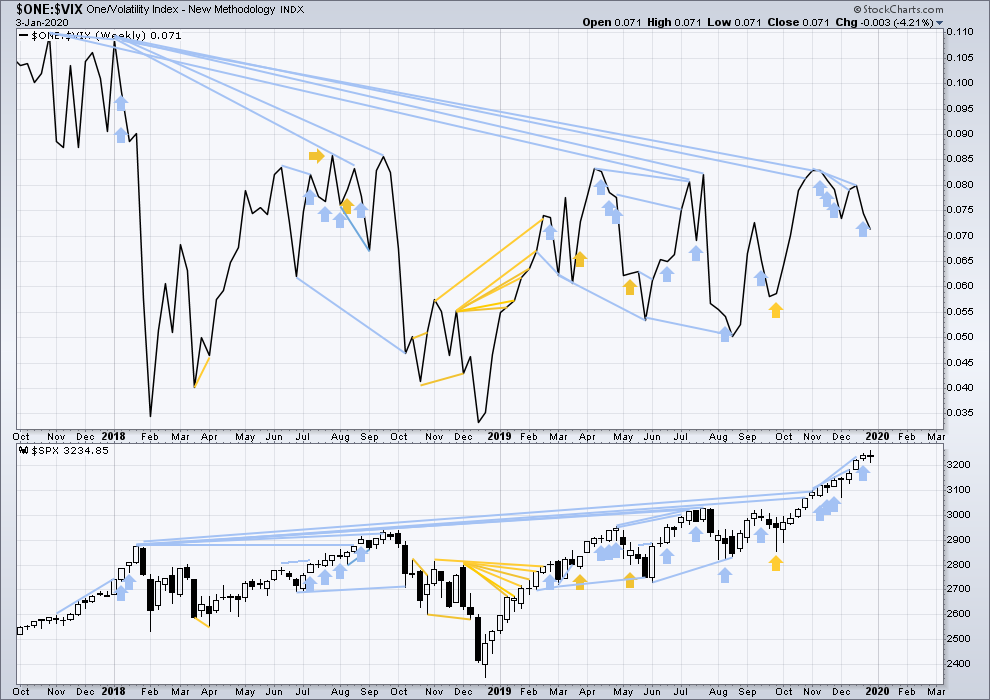
Click chart to enlarge. Chart courtesy of StockCharts.com. So that colour blind members are included, bearish signals
will be noted with blue and bullish signals with yellow.
The all time high for inverted VIX was on 30th October 2017. There is now over two years of bearish divergence between price and inverted VIX.
The rise in price is not coming with a normal corresponding decline in VIX; VIX remains elevated. This long-term divergence is bearish and may yet develop further as the bull market matures.
This divergence may be an early warning, a part of the process of a top developing that may take years. It may is clearly not useful in timing a trend change from bull to a fully fledged bear market.
Last week completes an outside week. Inverted VIX has declined during the week. There is no new short-term divergence.
DAILY CHART
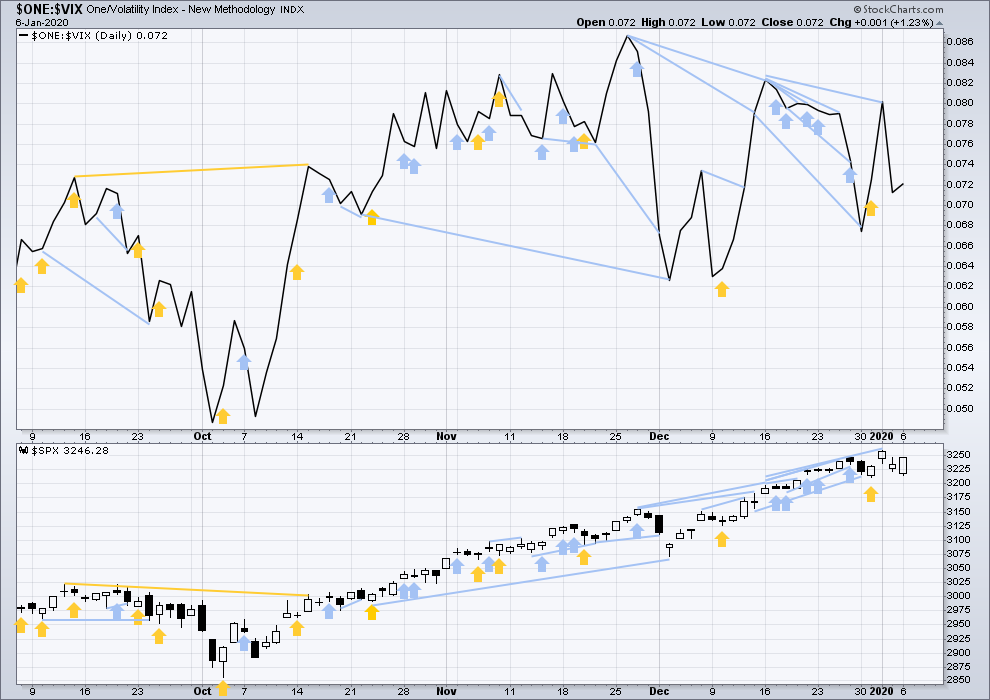
Click chart to enlarge. Chart courtesy of StockCharts.com. So that colour blind members are included, bearish signals
will be noted with blue and bullish signals with yellow.
Both price and inverted VIX have moved higher within Monday’s session. There is no new divergence. All of short, mid and long-term bearish divergences between price and inverted VIX remain.
DOW THEORY
Dow Theory confirmed a bear market in December 2018. This does not necessarily mean a bear market at Grand Super Cycle degree though; Dow Theory makes no comment on Elliott wave counts. On the 25th of August 2015 Dow Theory also confirmed a bear market. The Elliott wave count sees that as part of cycle wave II. After Dow Theory confirmation of a bear market in August 2015, price went on to make new all time highs and the bull market continued.
DJIA: 23,344.52 – a close on the 19th of December at 23,284.97 confirms a bear market.
DJT: 9,806.79 – price has closed below this point on the 13th of December.
S&P500: 2,532.69 – a close on the 19th of December at 2,506.96 provides support to a bear market conclusion.
Nasdaq: 6,630.67 – a close on the 19th of December at 6,618.86 provides support to a bear market conclusion.
With all the indices having moved higher following a Dow Theory bear market confirmation, Dow Theory would confirm a bull market if the following highs are made:
DJIA: 26,951.81 – a close above this point has been made on the 3rd of July 2019.
DJT: 11,623.58 – to date DJT has failed to confirm an ongoing bull market.
S&P500: 2,940.91 – a close above this point was made on the 29th of April 2019.
Nasdaq: 8,133.30 – a close above this point was made on the 26th of April 2019.
Published @ 07:10 p.m. EST.
—
Careful risk management protects your trading account(s).
Follow my two Golden Rules:
1. Always trade with stops.
2. Risk only 1-5% of equity on any one trade.
—
New updates to this analysis are in bold.

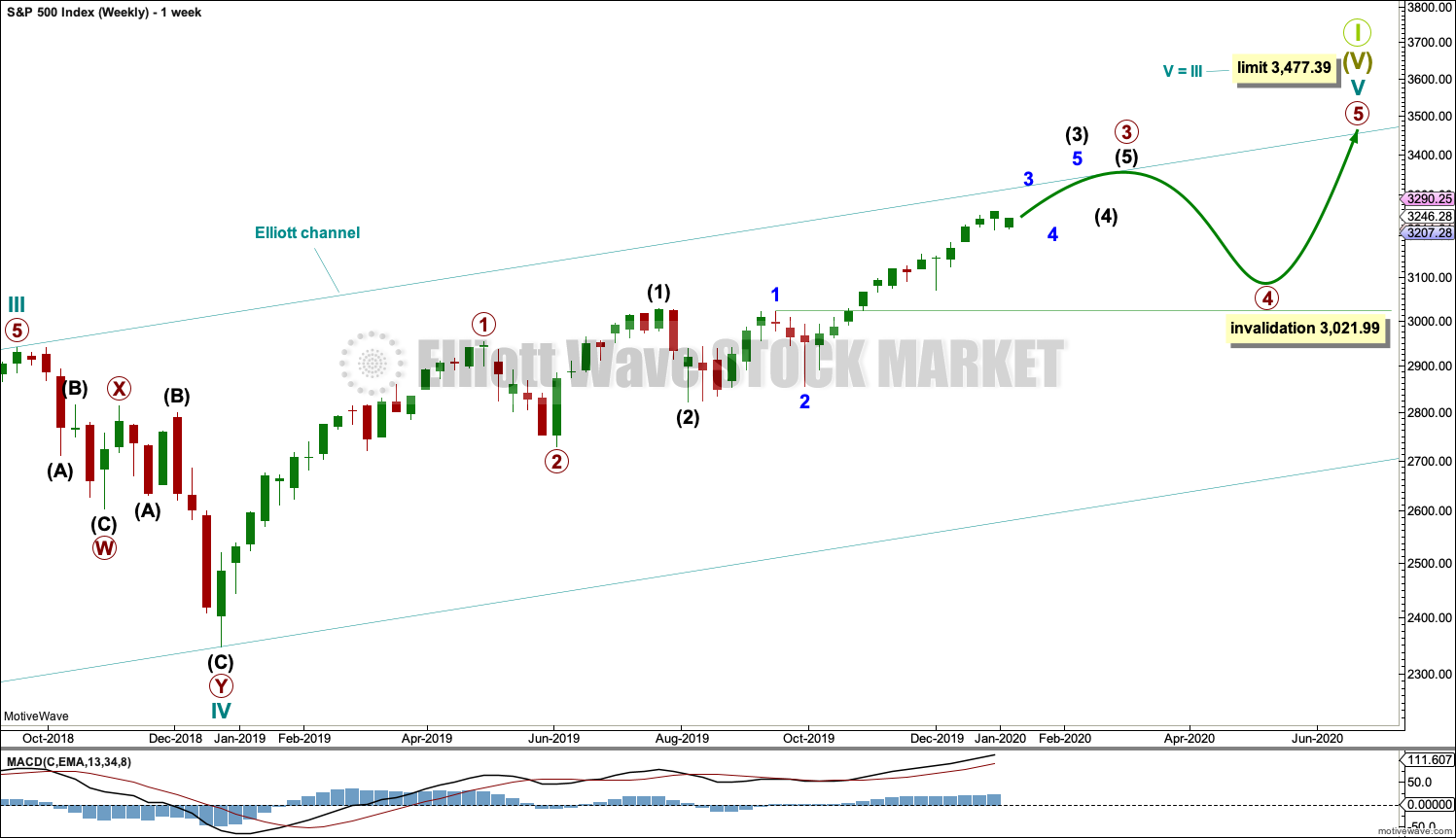
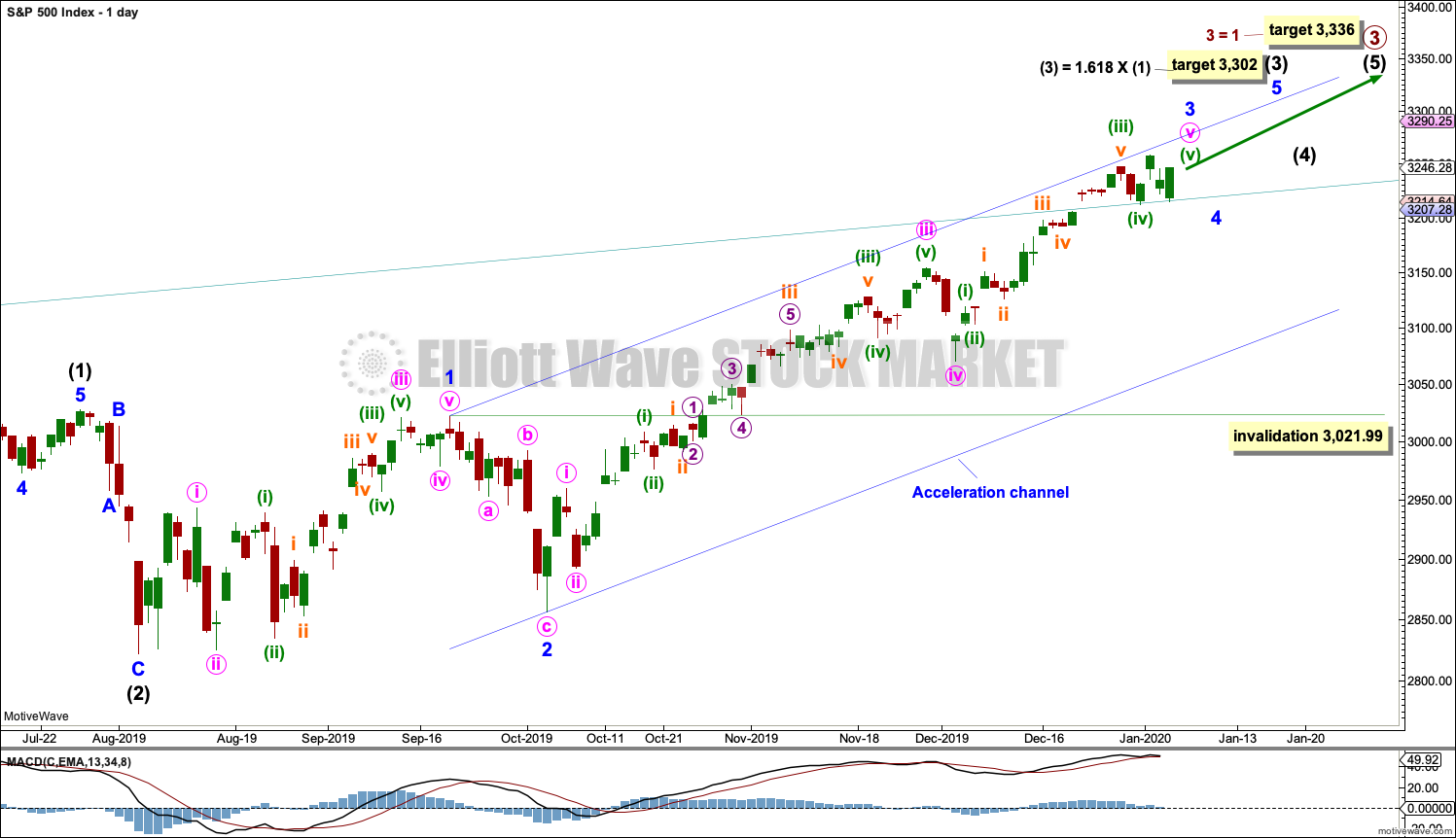
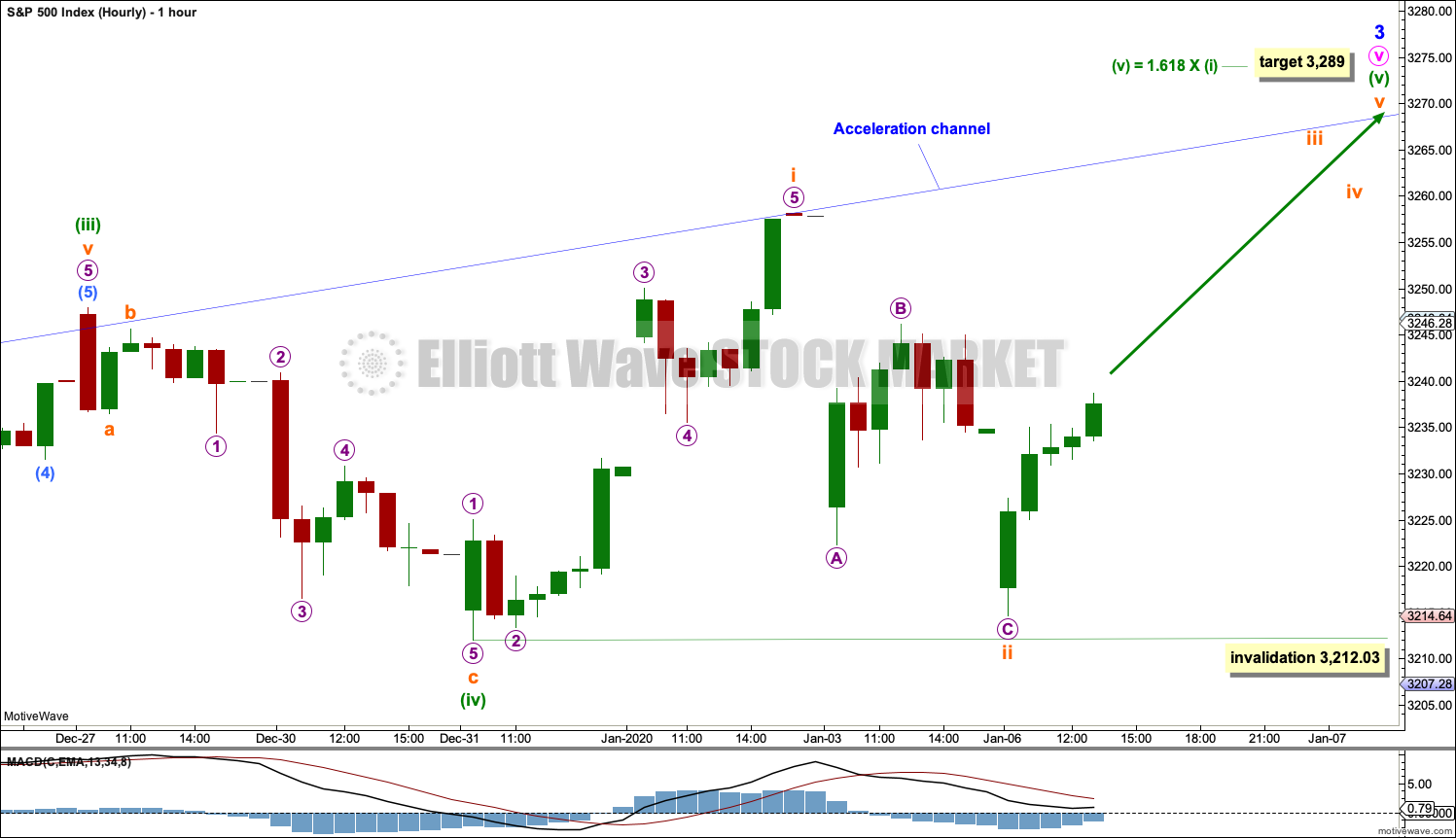
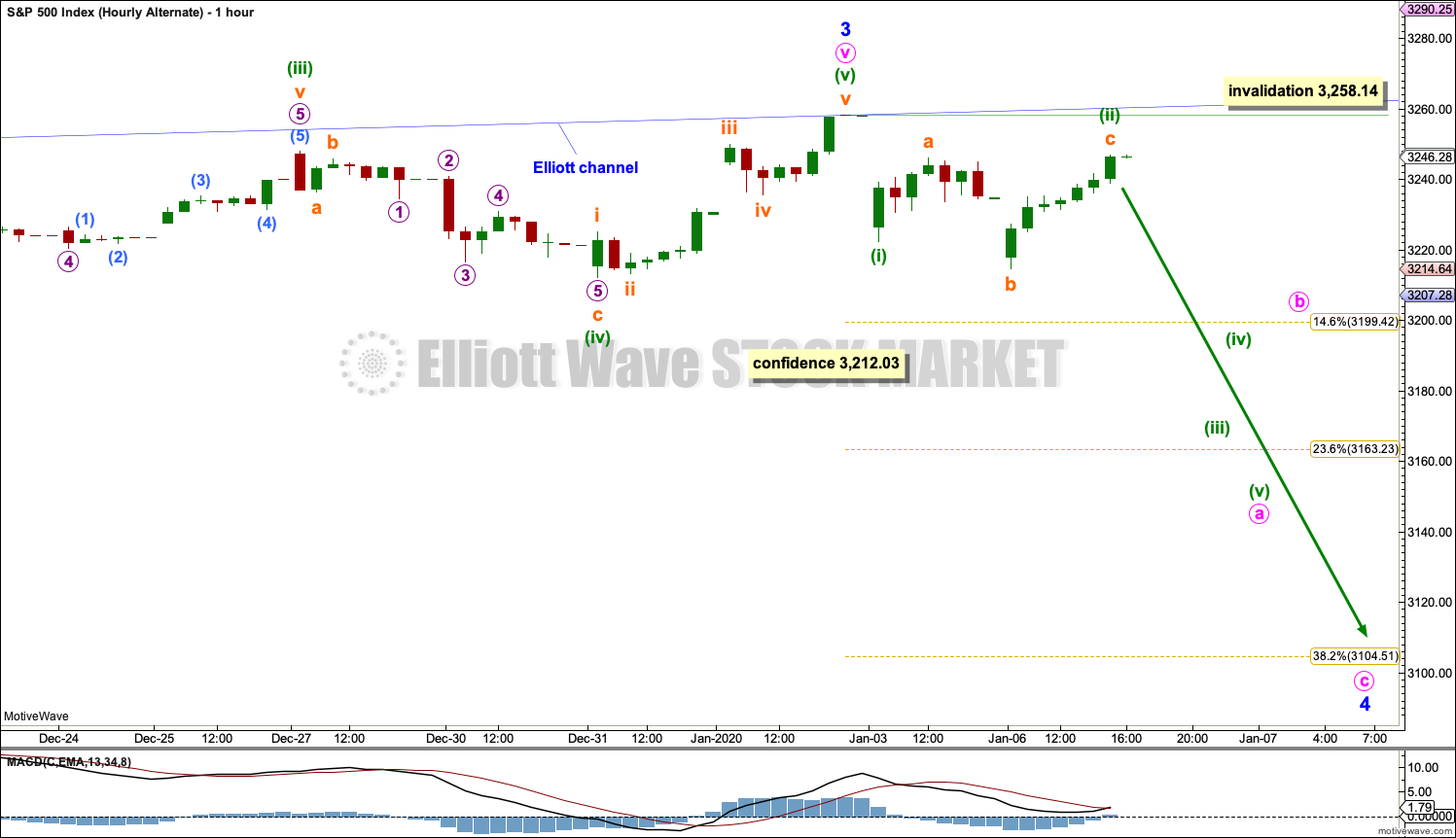
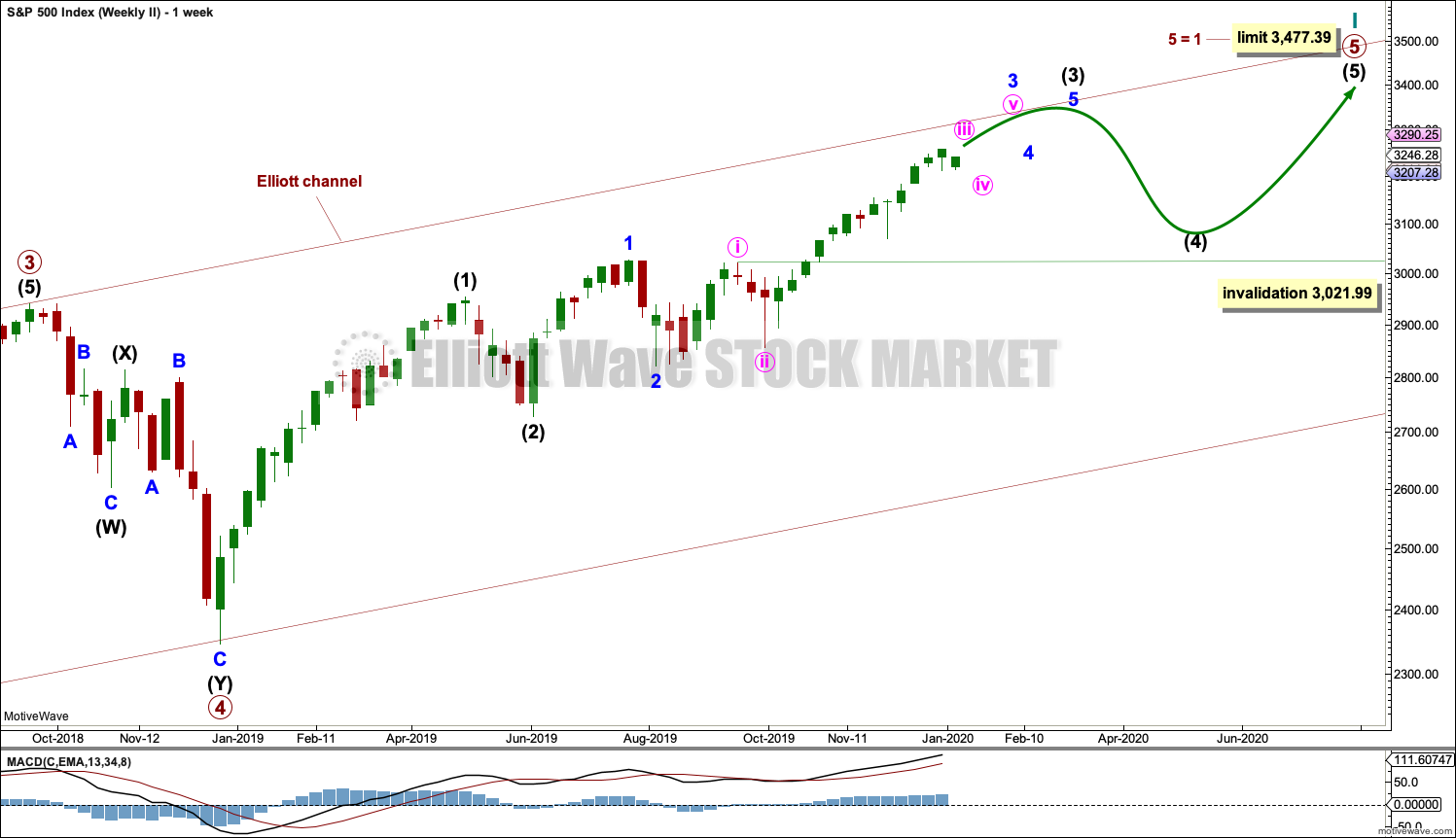
Bang!
Uh oh …
Yep… unless there’s a massive rebound overnight…
In all the anticipation of “where is SPX going?”, bitcoin has “exploded” to the upside by well over 20% in the last few days. The low was around 7800, which was one key target zone for completion of the 2 down. I have established a small long to see if it doesn’t double in the next month or so!! It’s quite possible.
Main hourly chart updated:
the analysis essentially remains the same today.
We need a break below 3,214.64 now for any confidence in a more bearish outlook for the short – mid term.
I’m travelling from Dunedin to the Catlins today, into one of the most remote, pristine and utterly beautiful parts of my country (IMO). Will post a couple of pics in comments later on.
Then to Invercargill where I am seeing my son Jack settled into student accommodation to begin his degree. I’m saying goodbye to my only son shortly and that’s really hard.
My thoughts are with you. Savor the moment and cement the fond memories into your heart and mind. It is a big step and transition for both of you.
Pics of your remote parts would be awesome.
Wait that doesn’t sound quite right. Pics of your remote regions … No, I mean pictures of the wild lands of NZ!
It’s possible the SPX is still in wave (iv) green, which develops into a triangle.
I’ve annotated this count on today’s hourly chart.
Expecting further weakness towards ~3225 before rallying in wave (v) green.
Really, really messy price action for the past several days. Last time it was like that was on 3-14 October 2019.
3225-3227 level would be exactly 61.8% retracement from yesterday’s action. Very possible.
Interestingly, /ES touched exactly 3226 and retraced back.
indeed, it is looking increasingly triangle-ish. but it could be general topping structure, and the H&S top structure continues to develop here.
I guess we would only find out if it breaks previous swing low below 3212 and stays there. Then it would definitely be start of minor wave 4.
Another observation: price is currently right in the middle of the acceleration channel which can be drawn all the way from 3rd of October’19 on the bottom which Lara refers to in her analysis.
I saw that too and was about to label it that way, but the upwards wave of B looks very much like a five and it should be a three.
Looking at /ES hourly w/overnight data again, to try to see “the whole battlefield”.
I see a lot of churn; I see high potential topping structure in development. Yup, a minor 4 could start any time. However…
I also see a strong up trend now established at this time frame in line with all higher time frames (ALL of them!), which is also just about to break above a 76-78% zone. RESPECT. Almost always indicates price is going to the 100% next (3257), and decent chances of extending to the 127% extension from there (3306). This is only the start of the third month after exiting from 8 months of squeeze; 8-12 months of rock solid upward price movement is indicated by that. Price is in a 3 of a (3) of a , and should be extremely high momentum and sustained, as it is indeed. This is where extensions are more likely to happen than anywhere.
However again…the down side risk is far larger than usual due to geopolitical instability. This market could be down 50, 100 points or more in a moment on news; always true but right now the potential for that is much higher. Which takes me back to the topping/churn. That behavior is a canary; this is what markets often do for awhile after a massive runnup, they churn at the top, THEN roll over and correct.
Strongly up through that 78% and continuing up…that’s a set up and a trigger for a short term trade to the ATH.
Breaking down again off the 78%…that’s starting to give us a head and shoulders top look; a break of the neckline would be a trigger, down to the measured move level which is exactly at the 38% retrace (can’t get away from fractal structure everywhere).
this shows the head and shoulders in development in SPX (daily)
Break down from the 76-78% retrace zone…but will that hold? Gap down and now a strong reversal AGAIN and price pushing up into (and through?) the gap. Wow. Just wow. All while a fuse is burning towards a massive powerkeg in the mideast. Crazy times.
Firstest!